加拿大简介(英文版)
加拿大简介(英文版)资料

Canadian national symbol: beaver(海狸)
Background
After the early European explorers realized that Canada was
not the spice-rich Orient, the main mercantile attraction was
Beautiful country to travel and explore
He Fei Fei
Contents ★ Background ★ Physical Geography
★ cities
★ Travel
Background Canada is a immigration country, every year there are about 150000 from more than 150 countries immigration is sworn in as a citizen of Canada. The real Canadian is native residents, also called the natives, they in the first before the arrival of immigrants has been in Canada live for thousands of years The official languages of Canada is English and French, speak English and French immigration in Canada have lived together for more than 300 years. In Canada, 98% of the people speak English or French, or at the same time can speak English of the two languages.
关于加拿大的介绍英语作文
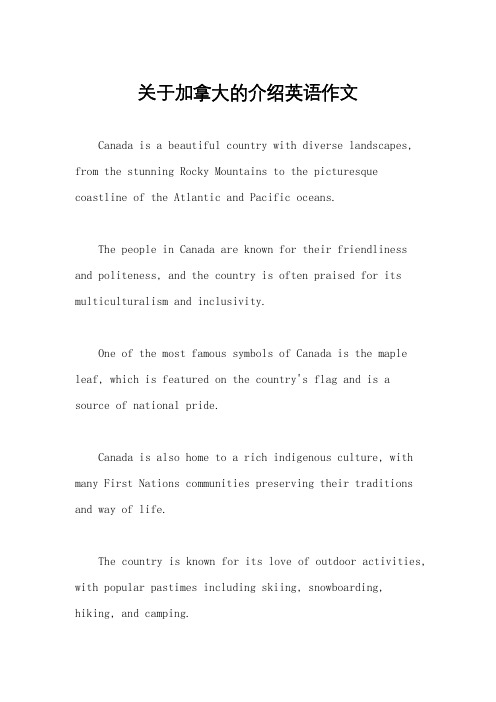
关于加拿大的介绍英语作文Canada is a beautiful country with diverse landscapes, from the stunning Rocky Mountains to the picturesque coastline of the Atlantic and Pacific oceans.The people in Canada are known for their friendliness and politeness, and the country is often praised for its multiculturalism and inclusivity.One of the most famous symbols of Canada is the maple leaf, which is featured on the country's flag and is a source of national pride.Canada is also home to a rich indigenous culture, with many First Nations communities preserving their traditions and way of life.The country is known for its love of outdoor activities, with popular pastimes including skiing, snowboarding, hiking, and camping.Canada is also famous for its wildlife, with opportunities to see bears, moose, and whales in their natural habitats.The cities in Canada are diverse and vibrant, with Toronto, Vancouver, and Montreal being some of the most popular destinations for visitors.The Canadian cuisine is a blend of different cultural influences, with dishes like poutine, butter tarts, and Nanaimo bars being popular across the country.The healthcare system in Canada is publicly funded, providing all citizens with access to medical care without the burden of high costs.Overall, Canada is a welcoming and beautiful country with a lot to offer to both its residents and visitors.。
Canadian(加拿大简介英文版)资料

Glacier Bay
Yukon Territory
Yukon is the westernmost and smallest of Canada's three federal territories. Whitehorse is the territorial capital and Yukon's only city.
British Columbia
Two forms of transportation are especially useful in this region: trains and cruise ships.
Canada route is very popular. Train service within Alaska, especially between
How Travelers Get There?
New York
How Travelers Get There?
Air: Four main Canadian gateways are: Vancouver(YVR), Edmonton(YEG), Toronto(YYZ)[tə'rɑnto] Montreal(YUL) [ˌmɑ:ntrɪ'ɔ:l]
Weather Patterns
Canada and Alaska have cold climates. Winters are snowy and freezing
Spring: Mar~Jun Summer:Jun~ Sep Fall:Sep~Dec nter:Dec~Feb The best time to visit is : May, June, or
国家英语介绍之加拿大
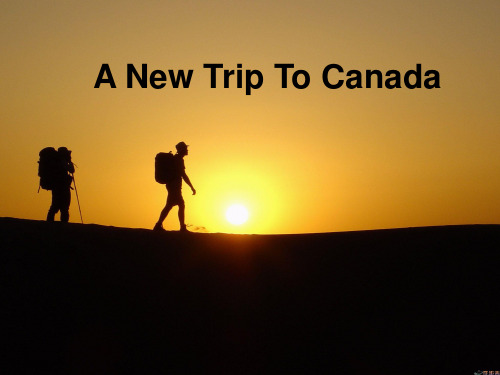
区位
加拿大是一个北美国家,由 十个省和三个地区组成。位 于北方大陆,它从大西洋东 部延伸到太平洋西部,往北 到北冰洋。跨越超过990万平 方公里。加拿大是世界上区 域占据第二,与美国共用的 边界是世界上最长的陆地边 界。
Canada is a federal state that is governed as a parliamentary democracy and a constitutional monarchy with Queen Elizabeth II as its head of state. It is a bilingual nation with both English and French as official languages at the federal level. As one of the world's most highlydeveloped countries, Canada has a diversified economy that is reliant upon its abundant natural resources and upon trade – particularly with the United States, with which Canada has had a long and complex relationship.
国歌
“啊,加拿大” 是加拿大的国歌。 这首歌最初是有 西奥多落魄泰勒 魁北克副省长委 托,圣让·巴蒂 斯特在1880年开 学典礼。歌词最 初在法国,1906 年翻译成英文。
National emblem 国徽
Culture of Canada
加拿大的文化
Canadian culture is a term that explains the artistic, musical, literary, culinary, political and social elements that are representative of Canada and Canadians, not only to its own population, but people all over the world. Canada's culture has historically been influenced by European culture and traditions, especially British and French.
加拿大简介(英文版)

Background
National Archives(档案 )
Name Capital Largest province Largest city
Canada Ottawa Quebec Toronto
Official language(s)
National anthem(国歌) national animal Currency
Physical Geography
A satellite composite image of Canada. Boreal 北方forests prevail on the rocky Canadian Shield, while ice and tundra冻原 are prominent突出 in the Arctic. Glaciers are visible in the Canadian Rockies and Coast Mountains. The flat and fertile prairies facilitate agriculture. The Great Lakes feed the St. Lawrence River in the southeast, where lowlands host much of Canada's population.
The maple leaf has served as a symbol celebrating the nature and environment of what is now Canada since the 18th century
Canadian national symbol: beaver(海狸)
Physical Geography Provinces and territories 1 2 3 4 5 6 7 8 9 10 11 12 13 British Columbia Alberta Saskatchewan Manitoba Ontario Quebec New Brunswick Nova Scotia Prince Edward Island Newfoundland & Labrador Yukon Northwest Territories Nunavut Provincial administrative club Victoria Edmonton Regina Winnipeg Toronto Quebec City Fredericton Halifax Charlottetown St. John's Whitehorse Yellowknife Iqaluit
加拿大长篇英文介绍作文

加拿大长篇英文介绍作文对于我来说,加拿大是一个令人向往的国家。
我第一次去加拿大是在大学的时候,我参加了一个暑期交换项目,去了多伦多。
那时候,我对加拿大的印象是一个多元文化的国家,人们非常友好,而且风景优美。
我还记得当时我去了尼亚加拉大瀑布,那壮丽的景色给我留下了深刻的印象。
英文:For me, Canada is a country that I have always longed to visit. My first trip to Canada was during my university years when I participated in a summer exchange program and went to Toronto. At that time, my impression of Canada was a multicultural country with incredibly friendly people and beautiful scenery. I still remember visiting Niagara Falls, and the magnificent view left a lasting impression on me.中文:对我来说,加拿大是一个我一直向往的国家。
我第一次去加拿大是在大学的时候,我参加了一个暑期交换项目,去了多伦多。
那时候,我对加拿大的印象是一个多元文化的国家,人们非常友好,而且风景优美。
我还记得当时我去了尼亚加拉大瀑布,那壮丽的景色给我留下了深刻的印象。
我在加拿大的这段经历让我深深地爱上了这个国家。
后来,我又有机会去了温哥华和蒙特利尔,这两个城市也给我留下了很深的印象。
温哥华的自然风光和宜居环境让我感到非常舒适,而蒙特利尔的欧洲风情和丰富的艺术氛围也让我流连忘返。
英文:My experiences in Canada have made me fall in love with the country even more. I had the opportunity to visit Vancouver and Montreal, and both cities left a deep impression on me. The natural beauty and livable environment of Vancouver made me feel incredibly comfortable, while the European charm and rich artistic atmosphere of Montreal kept me captivated.中文:我在加拿大的这段经历让我深深地爱上了这个国家。
英文版精美加拿大简介
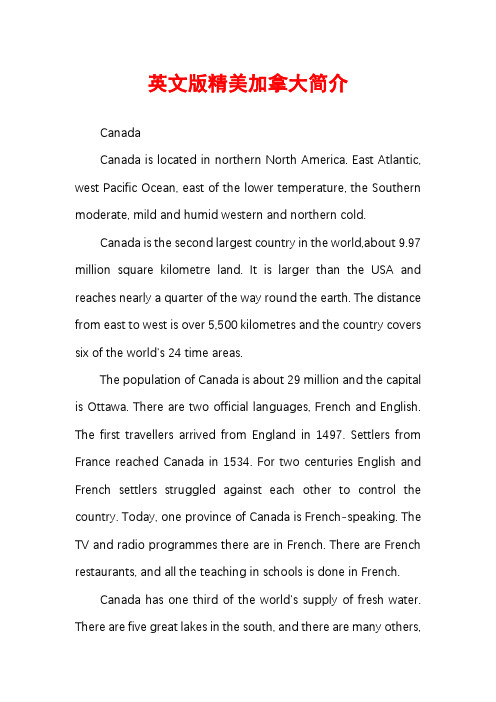
英文版精美加拿大简介CanadaCanada is located in northern North America. East Atlantic, west Pacific Ocean, east of the lower temperature, the Southern moderate, mild and humid western and northern cold.Canada is the second largest country in the world,about 9.97 million square kilometre land. It is larger than the USA and reaches nearly a quarter of the way round the earth. The distance from east to west is over 5,500 kilometres and the country covers six of the world's 24 time areas.The population of Canada is about 29 million and the capital is Ottawa. There are two official languages, French and English. The first travellers arrived from England in 1497. Settlers from France reached Canada in 1534. For two centuries English and French settlers struggled against each other to control the country. Today, one province of Canada is French-speaking. The TV and radio programmes there are in French. There are French restaurants, and all the teaching in schools is done in French.Canada has one third of the world's supply of fresh water. There are five great lakes in the south, and there are many others,especially in the north. Most of the electricity is produced by water. The country has a great deal of coal, oil and natural gas, and these are all exploited for energy. Much of the country is covered by forests, and wood is cut and sold all over the world. Canada is also the world's biggest producer of the kind of paper which is used for newspapers. Fishing is also very important for Canadians. Fish from the east and west coasts is sold to many other countries.The capital city of CanadaOttawa is the capital of Canada and is locatedon the banks of Ottawa, Rideau and Gatineau rivers. Canada’s fourth-largest city is a plementary blend of urban and rural lifestyles, old and new neighborhoods. culture and heritage, business and government.The Parliament BuildingThe Parliament Building is located inCanadian capital of Ottawa on Parliament Hill, which is a symbol of Ottawa and the Canada. Houses of Parliament by three Gothic buildings, divided into central, Eastern and western, the Canadian government and the Senate seat.The Vancouver Art GalleryThe Vancouver Art Gallery is the fifth-largestart gallery in Canada and the largest in Western Canada. It permanent collection of 10,000 artworks, which is all famous works. It is a worthwhile place where you can go.VancouverVancouver is located on the Pacific Coast insouthwestern British Columbia. Covering 114 square kilometers (44 square miles), it is the second-smallest area of eight major Canadian cities. The metropolitan area of 2,787 square kilometers (1,076 square miles) is the third-largest metropolitan area in Canada. In March 1995,the city of Vancouver won a silver medal as the second-best city in the world.TorontoToronto is a big, beautiful and efficient city, one that has emerged from relative obscurity over the past half century to e the center of culture, merce and munications in Canada. With its colorful ethnic mix, rich history and breathtaking architecture, Toronto offers non-stop adventures for the willing tourist. To get a sense of how big, various and magical Toronto is, the best place to start is the CN Tower, the tallest freestanding structure in the world. From this vantage point, visitors get a bird's-eye-view of the city's strikingskyline and unique geography.MontrealMontreal is a modern city in nearly every regard. Its downtown bristles with skyscrapers, but these are playful, almost perky , with unexpected shapes. The city aboveground is mirrored by another below, where an entire winter can be avoided in coatless fort. To the west and north of downtown are Anglo mercial and residential neighborhoods, centered around Westmount. To the east and north are Francophone quarters, centered on Outremont and Plateau Mont-Royal.native land! True patriot love in all thy sons mand. With glowing hearts we see thee rise, The True North strong and free! From far and wide, O Canada, we stand on guard for thee. God keep our land glorious and free! O Canada, we stand on guard for thee. O Canada, we stand on guard for thee.The National Anthem of Canada ( 加拿大国歌) 啊加拿大! O Canada! Our home and我们的家园与故土!你的儿女,忠诚爱国。
加拿大介绍资料英文
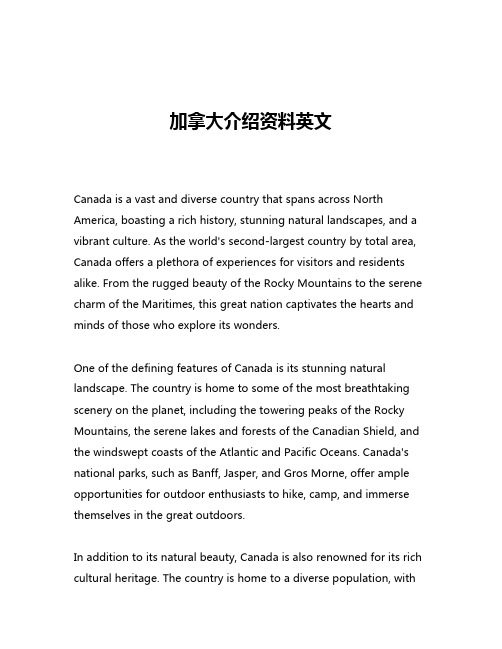
加拿大介绍资料英文Canada is a vast and diverse country that spans across North America, boasting a rich history, stunning natural landscapes, and a vibrant culture. As the world's second-largest country by total area, Canada offers a plethora of experiences for visitors and residents alike. From the rugged beauty of the Rocky Mountains to the serene charm of the Maritimes, this great nation captivates the hearts and minds of those who explore its wonders.One of the defining features of Canada is its stunning natural landscape. The country is home to some of the most breathtaking scenery on the planet, including the towering peaks of the Rocky Mountains, the serene lakes and forests of the Canadian Shield, and the windswept coasts of the Atlantic and Pacific Oceans. Canada's national parks, such as Banff, Jasper, and Gros Morne, offer ample opportunities for outdoor enthusiasts to hike, camp, and immerse themselves in the great outdoors.In addition to its natural beauty, Canada is also renowned for its rich cultural heritage. The country is home to a diverse population, withIndigenous peoples, French Canadians, and a multitude of immigrant communities contributing to the nation's unique identity. This diversity is reflected in the country's vibrant arts and music scenes, with world-class museums, galleries, and performance venues showcasing the creativity and talent of Canadian artists.One of the most striking aspects of Canadian culture is its bilingual nature. Both English and French are official languages in Canada, with French predominantly spoken in the province of Quebec. This linguistic duality has played a significant role in shaping the country's identity and political landscape, contributing to a unique blend of European and North American influences.Canada's economy is also a point of pride, with the country ranking among the world's wealthiest and most stable economies. The nation's strong economic performance is driven by a diverse range of industries, including natural resources, manufacturing, technology, and finance. Canada is also a leader in sustainable development, with a focus on renewable energy and environmental protection.In terms of governance, Canada is a constitutional monarchy with Queen Elizabeth II as the head of state. The country operates under a parliamentary system of government, with a Prime Minister serving as the head of the executive branch. Canada is known for its strong democratic institutions, its commitment to human rights, and its roleas a global leader in peacekeeping and international cooperation.One of the most fascinating aspects of Canada is its regional diversity. Each province and territory within the country has its own unique character, from the rugged wilderness of the North to the vibrant urban centers of the South. Whether you're exploring the historic streets of Quebec City, enjoying the cosmopolitan delights of Toronto, or discovering the natural wonders of the Canadian Rockies, there is always something new and exciting to discover.For those interested in visiting Canada, the country offers a wealth of opportunities for exploration and adventure. From the bustling cities of Vancouver and Montreal to the quaint fishing villages of the Maritimes, there is something to captivate every traveler. Whether you're interested in outdoor activities, cultural experiences, or simply soaking in the natural beauty of the land, Canada is a destination that is sure to leave a lasting impression.In conclusion, Canada is a remarkable country that combines natural splendor, cultural richness, and economic prosperity. From its towering mountains to its serene coastlines, Canada offers a diverse array of experiences that continue to attract visitors from around the world. As a global leader in sustainability, innovation, and international cooperation, Canada is a nation that truly embodies the values of unity, diversity, and progress.。
Canada加拿大简介(英文)

Toronto is Canada's
largest city, the provincial capital of Ontario, the national industrial and commercial center. Toronto is located in the northwest shore of lake Ontario, has more than 2.5 million people, is North America's fifth largest city.
Montreal [,mɔntri'ɔ:l] 蒙特利尔
Province of Ontario [ɔn‘tεəriəu] 安大略省
Ottawa
It’s the capital of Canada, it's also the fourth largest city of Canada.
The most famous building is Canada's Parliament ['pɑːləm(ə)nt] buildings(加拿 大议会大厦)
Canada’s food
Staple ['steɪp(ə)l] food(主食):rice and pasta. Non-staple (副食) food: beef ,eggs ,tomatoes ,potatoes ,melons and so on.
加拿大的饮食文化
•不设烟酒
在加拿大有禁烟规定,并且必须年满16岁以上者方可购买香烟。在联邦政府 大楼、电梯、银行、商店、学校及多数公共场所吸烟都是违法的。如发现有人在 酒楼、餐馆吸烟不加制止或者是纵容其吸烟,可能会被处以5000加元罚款。对 酒也是如此,如阿尔伯塔省规定,19岁以上者方可买烟,而烈性白酒则被禁止出 卖。另外,餐厅、酒吧只可在早上11时到凌晨1时卖酒,饮酒者只能在领有酒牌 的地方或住宅内喝酒,在这些地方以外饮酒都是违法的。
英文版精美加拿大简介

Vancouver
Vancouver is located on the Pacific Coast in
southwestern British Columbia. Covering 114 square kilometers (44 square miles), it is the second-smallest area of eight major Canadian cities. The metropolitan area of 2,787 square kilometers (1,076 square miles) is the third-largest metropolitan area in Canada. In March 1995,the city of Vancouver won a silver medal as the second-best city in the world.
3
Canada has one third of the world's supply of fresh water. There are five great lakes in the south, and there are many others, especially in the north. Most of the electricity is produced by water. The country has a great deal of coal, oil and natural gas, and these are all exploited for energy.
Much of the country is covered by forests, and wood is cut and sold all over the world. Canada is also the world's biggest producer of the kind of paper which is used for newspapers. Fishing is also very important for Canadians. Fish from the east and west coasts is sold to many other countries.
加拿大长篇英文介绍作文

加拿大长篇英文介绍作文I have always been fascinated by the vast and diverse country of Canada. From its stunning natural landscapes to its rich cultural heritage, there is so much to explore and learn about in this beautiful country.英文,Canada is known for its breathtaking natural beauty, such as the majestic Rocky Mountains, the stunning Niagara Falls, and the picturesque coastline of theAtlantic provinces. The country is also home to a vibrant and diverse culture, with influences from Indigenous peoples, French and British settlers, and immigrants from all over the world. Whether you're exploring the historic streets of Old Quebec, taking in a hockey game in Toronto, or hiking through the rugged wilderness of Banff National Park, there is always something new and exciting to discover in Canada.中文,加拿大以其令人惊叹的自然美景而闻名,如雄伟壮丽的落基山脉、令人惊叹的尼亚加拉瀑布以及大西洋省份的风景如画的海岸线。
加拿大简介英文作文
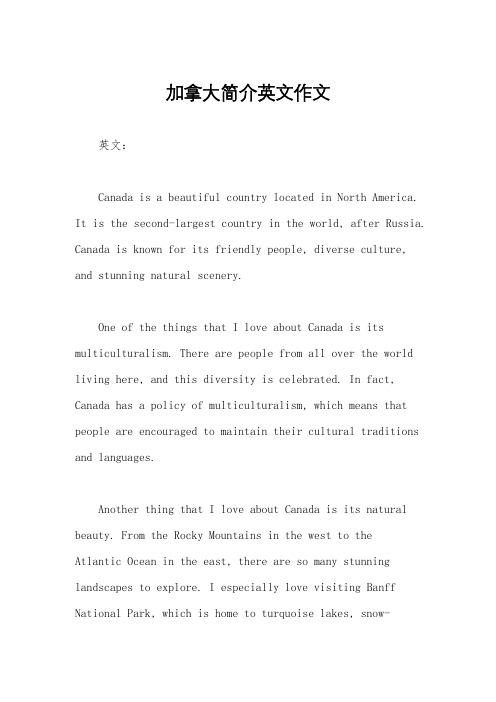
加拿大简介英文作文英文:Canada is a beautiful country located in North America. It is the second-largest country in the world, after Russia. Canada is known for its friendly people, diverse culture, and stunning natural scenery.One of the things that I love about Canada is its multiculturalism. There are people from all over the world living here, and this diversity is celebrated. In fact, Canada has a policy of multiculturalism, which means that people are encouraged to maintain their cultural traditions and languages.Another thing that I love about Canada is its natural beauty. From the Rocky Mountains in the west to theAtlantic Ocean in the east, there are so many stunning landscapes to explore. I especially love visiting Banff National Park, which is home to turquoise lakes, snow-capped peaks, and abundant wildlife.Canada is also known for its high quality of life. The healthcare system is excellent, and education is accessible to all. In addition, the crime rate is low, making it a safe place to live and raise a family.Overall, Canada is a wonderful country with so much to offer. Whether you're looking for adventure, culture, or a peaceful way of life, Canada has something for everyone.中文:加拿大是一个位于北美洲的美丽国家。
Canadian(加拿大简介英文版)

Weather Patterns
Canada and Alaska have cold climates. Winters are snowy and freezing Spring: Mar~Jun Summer:Jun~ Sep Fall:Sep~Dec Winter:Dec~Feb The best time to visit is : May, June, or September.
• Thank you!
• 张悦 5468879 • 戴志伟5468543 • 赵婧祎4844414 • 许博远4844800
gara
Ice fields Parkway
Algonquin Provincial Park
sales strategy
Target marketing
Self-driving tours Study abroad Settle down
Sea to sky highway
Mendenhall Glacier Glacier Bay
Yukon Territory
Yukon is the westernmost and smallest of Canada's three federal territories. Whitehorse is the territorial capital and Yukon's only city. This territory to the north of British Colimbia is often accessed via a motorcoach train journey from skagway, Alaska, as part of a cruise shore excursion.Yukon's frontier gold rush spirit is best experienced at its two principal cities.Whitehorse and Dawson City.
用英语介绍加拿大5句话

用英语介绍加拿大5句话
1、Canada , located in the northernmost North America, is one of the commonwealth countries.
It is known as the "maple leaf country" reputation.
Canada is a highly developed capitalist country.
2、中文翻译
加拿大,位于北美洲最北端,英联邦国家之一,素有“枫叶之国”的美誉。
首都是渥太华,著名城市有多伦多、温哥华等。
加拿大西抵太平洋,东迄大西洋,北至北冰洋。
加拿大是一个高度发达的资本主义国家。
扩展资料:
官方语言有英语和法语两种,是典型的双语国家。
加拿大政治体制为联邦制和议会制君主立宪制,英王伊丽莎白二世为国家元首及国家象征,但无实际权力。
加拿大原为印第安人与因纽特人的居住地。
16世纪后,英国和法国殖民者先后侵入;1763年沦为英国殖民地。
1867年成为英国自治领。
1926年英国承认其"平等地位",获得外交独立权。
加拿大是八国集团、20国集团、北约、联合国、法语国家组织、世界贸易组织等国际组织的成员国。
加拿大中英简介
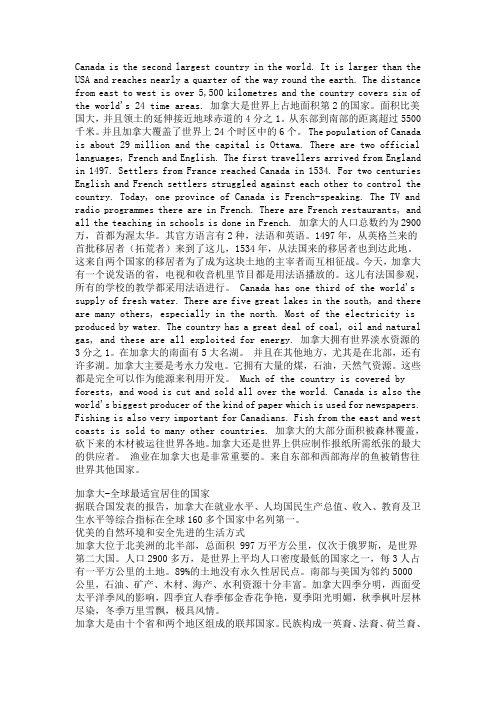
Canada is the second largest country in the world. It is larger than the USA and reaches nearly a quarter of the way round the earth. The distance from east to west is over 5,500 kilometres and the country covers six of the world's 24 time areas. 加拿大是世界上占地面积第2的国家。
面积比美国大,并且领土的延伸接近地球赤道的4分之1。
从东部到南部的距离超过5500千米。
并且加拿大覆盖了世界上24个时区中的6个。
The population of Canada is about 29 million and the capital is Ottawa. There are two official languages, French and English. The first travellers arrived from England in 1497. Settlers from France reached Canada in 1534. For two centuries English and French settlers struggled against each other to control the country. Today, one province of Canada is French-speaking. The TV and radio programmes there are in French. There are French restaurants, and all the teaching in schools is done in French. 加拿大的人口总数约为2900万,首都为渥太华。
加拿大英文简介
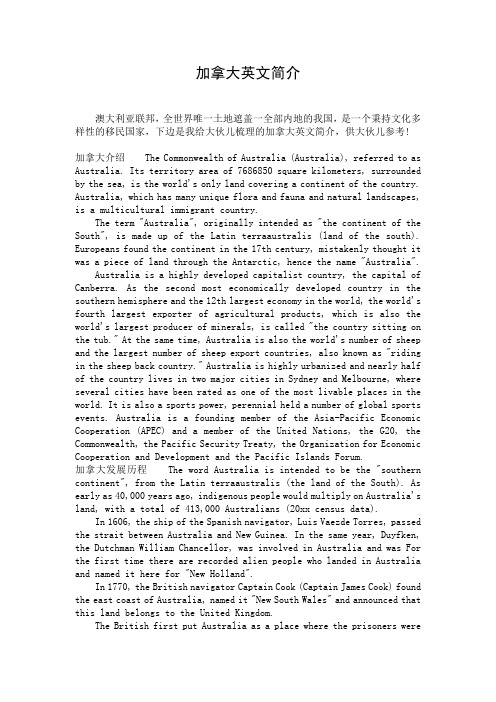
加拿大英文简介澳大利亚联邦,全世界唯一土地遮盖一全部内地的我国,是一个秉持文化多样性的移民国家,下边是我给大伙儿梳理的加拿大英文简介,供大伙儿参考!加拿大介绍The Commonwealth of Australia (Australia), referred to as Australia. Its territory area of 7686850 square kilometers, surrounded by the sea, is the world's only land covering a continent of the country. Australia, which has many unique flora and fauna and natural landscapes, is a multicultural immigrant country.The term "Australia", originally intended as "the continent of the South", is made up of the Latin terraaustralis (land of the south). Europeans found the continent in the 17th century, mistakenly thought it was a piece of land through the Antarctic, hence the name "Australia".Australia is a highly developed capitalist country, the capital of Canberra. As the second most economically developed country in the southern hemisphere and the 12th largest economy in the world, the world's fourth largest exporter of agricultural products, which is also the world's largest producer of minerals, is called "the country sitting on the tub." At the same time, Australia is also the world's number of sheep and the largest number of sheep export countries, also known as "riding in the sheep back country." Australia is highly urbanized and nearly half of the country lives in two major cities in Sydney and Melbourne, where several cities have been rated as one of the most livable places in the world. It is also a sports power, perennial held a number of global sports events. Australia is a founding member of the Asia-Pacific Economic Cooperation (APEC) and a member of the United Nations, the G20, the Commonwealth, the Pacific Security Treaty, the Organization for Economic Cooperation and Development and the Pacific Islands Forum.加拿大发展历程The word Australia is intended to be the "southern continent", from the Latin terraaustralis (the land of the South). As early as 40,000 years ago, indigenous people would multiply on Australia's land, with a total of 413,000 Australians (20xx census data).In 1606, the ship of the Spanish navigator, Luis Vaezde Torres, passed the strait between Australia and New Guinea. In the same year, Duyfken, the Dutchman William Chancellor, was involved in Australia and was For the first time there are recorded alien people who landed in Australia and named it here for "New Holland".In 1770, the British navigator Captain Cook (Captain James Cook) found the east coast of Australia, named it "New South Wales" and announced that this land belongs to the United Kingdom.The British first put Australia as a place where the prisoners wereexiled. On January 18, 1788, a fleet of six ships, led by Captain Philip, arrived in Australia's Botany Bay, where there were 736 prisoners. Eight days later, on January 26, 1788, they officially established the first British colonial area in PortJackson, Australia, where the population grew and became the largest city in Australia, Sydney, the name is to commemorate the British Minister of the Interior Sydney (Sydney). January 26 each year to become Australia's National Day (AustraliaDay).In 1790, the first free immigrants from the United Kingdom moved to Australia, with Sydney as the center, gradually to the inland development, to 1803, the colonial area has been extended to today's Tasmania. The earliest inhabitants of Australia are indigenous.In 1900 the inhabitants of all six colonies held a one-to-one referendum, using a vote to decide whether to reorganize the six colonies into a federal state, the result of which was to be unified in six places and to establish a single Australian federation. In July, the British Parliament passed the Australian Federal Constitution and the British Dominion Ordinance.January 1, 1901, Australia's colonial areas to the state, the six colonial areas to become a federal, the establishment of the Australian Commonwealth. While passing the first constitution.In 1927, the Australian capital moved to Canberra.In 1931, the British Parliament passed the "Westminster Act", so that Australia gained internal and political autonomy, become an independent state in the Commonwealth.In 1986, the British Parliament passed the "Australian Relations Act", Australia to obtain full legislative and judicial final.In the 1850s, gold was found in New South Wales and Victoria. A large number of gold rush from Europe, the Americas and China flocked. The population of Australia surged from 400,000 in 1850 to 1.1 million in 1860. Since then many important gold mines have been discovered one by one, and found a lot of mineral deposits, these discoveries, so that Australia quickly get rich and development.加拿大文化艺术the filmAustralian films are influential in the world. Before the Second World War, Australia began to produce films, many of them excellent works. After the Second World War the Australian film industry in a standstill. It was not until the 1970s that the Australian film development company was set up by the leader of the Labor Party, led by Labor's leader, who was renamed the Australian Film Commission (AFC). The film committee has set up the government's own film production agency, the Australian Film Board, shooting a large number of films, becoming the first round of the history of Australian film production heat. Newspaper columnist and advertising giant Philip Adams was one of the celebrities who were actively involved in the film's hot.So far, Australian producers and directors have won an indisputable position in the global film industry with their unique style, and have a strong impact on Hollywood, and many Hollywood studios indicate the need for Australian actors to star in. The Australian traveler in Hollywood is therefore known as "Eucalyptus Leaf Help", including a number of presenters, directors and actors who are now active in Hollywood. The famous directors include Baz Rulman, Alex Prius, George Miller and Wen Ziren. Famous actors include Russell Crowe, Nicole Kidman, Kate Blanchett, Hugh Jackman and Gay Pierce, etc., Heath Ledger, Sam Worthington.LiteratureIn 1973, the Australian government established the Arts Council Literary Committee, literature began to develop, local literature has a certain international influence, such as Marcus Clark in 1874 to create "life imprisonment." In the late nineteenth century, the Australian jungle poets began to get out of the shadow of British traditional culture by seeking more "Australian" sense of belonging. Since the 1920s, the outstanding Australian literature has "Koonaldu", "Kabri Connie" and "Poor fellow, my hometown".MediaAustralia has four press groups: Herald and Time magazine group, Murdoch news company, Fairfax and Parker News joint holding company. Among them, Murdoch news company developed the fastest, now also bought the British "The Times" and the United States "New York Post", has become an international newspaper group. The main newspapers are: "Australian newspaper", "Sydney Morning Herald", "Century", "Financial Review", "Canberra Times." Australia has more than 1,400 journals, "Australian Women's Weekly" is the largest circulation of publications. "Gazette" magazine (founded in 1880) is one of the oldest publications. The Australian news agency is Australia's largest news agency, headquartered in Sydney, 1964 and Reuters became associates.physical educationAustralia is a big sport, sports are quite popular. International sports arena, Australia's cricket, hockey, basket tennis, rugby and federated rugby have first-class levels; bicycles, rowing, swimming are also among the best in the world. Other domestic sports include Australian football, soccer, horse racing, racing, tennis, basketball, golf and track and field.Australia has hosted two summer Olympic Games, namely the 1956 Melbourne Olympics and the 20xx Sydney Olympics. Australia's medal in the Olympic Games has long been the top five in the world, swimming and track and field projects usually bring many medals. In addition, Australia is one of the holy places of global tennis, one of the four Grand Slam of the Australian Open in January each year in Melbourne. Melbourne's Abel Park track is the first race of Formula One racing (F1). Australia's watersports is very powerful, long-term in the Olympic Games to achieve good results, "water lion," said.FootballAustralianRulesFootball is unique to Australia and the Australian Australian Football Federation (AFL) is very popular. Now the British football is also popular, the establishment of the A-League British Football League. In recent years, the Australian national soccer team has become one of the most popular group sports teams in Australia. In 20xx, it joined the Asian Football Association and performed well in the 20xx World Cup soccer tournament. After entering the 16th, the Australian national football team lost to the world champion Football team, in 20xx is the World Cup top ten semi-finals eight unbeaten record once again into the 20xx World Cup finals in South Africa, but eventually still in the first ring was eliminated.TennisAustralia is a big tennis player, there are a number of Grand Slam tennis stars, such as Bo Kashi, Rhodes Lavo, Patrick Lough, Leiden Hewitt, Alicia Molik, Sa Mansa Stosur, Margaret Colt, John Newcomb and so on.Australia's sports clubs are scattered throughout the country, and some high school and university sports clubs produce most of the sports elite for the country. In this regard, Australia is similar to the sporting country of the United States. Australian Tennis Open (English: AustralianOpen, referred to as: Australian Open) is one of the four Grand Slam tournaments. The match is usually held in Melbourne, Victoria, Australia, in the last two weeks of January each year, and is one of the first to be held in the annual Grand Slam.The Australian Open was founded in 1905 and has a history of more than 100 years. But compared with the other three Grand Slam events, the Australian Open is still the youngest. At the beginning of the competition was named the "Australasian Championship" (AustralasianChampionships); in 1969, the game into the "Open era." Since 1988, the competition has been carried out on the outdoor hard earth court in Melbourne Park.Competition with men's singles and doubles, women's singles and doubles and mixed doubles and other projects. The men's singles championship trophy is the NormanBrookesChallengeCup, the women's singles championship trophy is the Daphne Akhurst Memorial Cup (DaphneAkhurstMemorialCup).SwimIan James Thorpe is Australia's swimming star, has won five Olympic gold medals, is Australia's highest record so far.living habitAlthough Australia is often portrayed as a country dominated by rural areas, in fact, the dominant is the urban culture and metropolitan way of life, including the enjoyment of the world's delicacies.Australians like to drink beer, leisure time, especially the weekend, many people like friends and friends to the bar drinking chat, enjoy music, or to the park barbecue. Australia's cities give people a sense of openness, there are many open parks and green dotted the meantime. The vast majority of parks in Australia are free, the park is not even the walls, all the way out of the park path. Convenient transportation can also take people effortlessly into the national parks in the suburbs of the city.Unrestrained is the best general for Australians, Australia has a particularly strong atmosphere of freedom and freedom. People call their names every day (only called names, not names), between bosses and employees, between teachers and students. In the two cities of Sydney and Melbourne city center, usually at noon can usually see wearing a suit of white-collar workers or white-collar beauty and friends and colleagues together, sitting on the steps in front of the building to eat a simple lunch, such as sandwiches or hot dogs , White-collar people sitting on the street to eat lunch, the same is a modern metropolis, the same scene in Tokyo or Hong Kong such a place is unimaginable.Recreational activitiesAustralians love outdoor life, for example: climb the Sydney Bridge, three hundred and sixty degrees to enjoy the magnificent view of Sydney Harbor. Swim with dolphins, visit penguin paradise, come to Australia to see wild animals, ride camels walk, ride, adventure, all kinds of exciting activities everything.The Australians are both cheerful and Westerners. They are interested in sports, such as surfing, windsurfing, horse racing, fishing, bowling, Australianrulesfootball, cricket, rugby, netball and swimming There are many enthusiasts.。
- 1、下载文档前请自行甄别文档内容的完整性,平台不提供额外的编辑、内容补充、找答案等附加服务。
- 2、"仅部分预览"的文档,不可在线预览部分如存在完整性等问题,可反馈申请退款(可完整预览的文档不适用该条件!)。
- 3、如文档侵犯您的权益,请联系客服反馈,我们会尽快为您处理(人工客服工作时间:9:00-18:30)。
Background Coat of arms of Canada ( 加拿大国徽)
Crown
Crest
Helm supporters Shield(盾) Ribbon Motto compartment
Background Canadian national symbol: Marple leaf
Background
National Archives(档案 )
Name Capital Largest province Largest city
Canada Ottawa Quebec Toronto
Official language(s)
National anthem(国歌) national animal Currency
official sports
English and French
O Canada beaver( 海狸) Canadian dollar ($) (CAD )
lacrosse(长曲棍球) and hockey( 冰球)
Background National Flag of Canada
The National Flag of Canada, also known as the Maple Leaf, and (French for "the one-leafed"), is a red flag with a white square in its centre, featuring a stylized 11-pointed red maple leaf. Its adoption in 1965 marked the first time a national flag had been officially adopted in Canada to replace the Union Flag. Designed by George F. G. Stanley, John Matheson
Ottawa is the capital of Canada. It is the second largest city in the Province of Ontario and the fourth largest city in the country. The city is located on the south bank of the Ottawa River in the eastern portion of Southern Ontario. Ottawa borders Gatineau, Quebec, located on the north bank of the Ottawa River; together they form the National Capital Region (NCR). Ottawa is also home to major arts and sciences facilties including the Ottawa National Museum of Civilization, The Science and interesting Tech Museum, The National Gallery of Canada, The National Arts Centre in Ottawa.
Physical Geography
Provinces and territories
Canada is a federation composed of ten provinces and three territories. Provinces have more autonomy than territories, having responsibility for social programs such as health care, education, and welfare. Together, the provinces collect more revenue than the federal government, an almost unique structure among federations in the world. Using its spending powers, the federal government can initiate national policies in provincial areas, such as the Canada Health Act; the provinces can opt out of these, but rarely do so in practice. Equalization payments are made by the federal government to ensure that reasonably uniform standards of services and taxation are kept between the richer and poorer provinces.
Physical Geography
A satellite composite image of Canada. Boreal 北方forests prevail on the rocky Canadian Shield, while ice and tundra冻原 are prominent突出 in the Arctic. Glaciers are visible in the Canadian Rockies and Coast Mountains. The flat and fertile prairies facilitate agriculture. The Great Lakes feed the St. Lawrence River in the southeast, where lowlands host much of Canada's population.
Physical Geography
A clickable map of Canada exhibiting its ten provinces and three territories, and their capitals.
☆
Cold Capital ---- Ottawa(渥太华)
cities
Background
After the early European explorers realized that Canada was not the spice-rich Orient, the main mercantile attraction was the beaver, then a population numbering in the millions. In the late 1600s and early 1700s, the fashion of the day demanded fur top-hats, which needed beaver pelts. As these hats became more popular, the demand for the pelts grew. Explorers were dispatched deep into the North American ☆ wilderness to trap and trade for furs with local natives.
Physical Geography Provinces and territories 1 2 3 4 5 6 7 8 9 10 11 12 13 British Columbia Alberta Saskatchewan Manitoba Ontario Quebec New Brunswick Nova Scotia Prince Edward Island Newfoundland & Labrador Yukon Northwest Territories Nunavut Provincial administrative club Victoria Edmonton Regina Winnipeg Toronto Quebec City Fredericton Halifax Charlottetown St. John's Whitehorse Yellowknife Iqaluit
Physical Geography
Canada occupies a major northern portion of North America, sharing the land borders with the contiguous United States to the south and the US state of Alaska to the northwest. Canada stretches from the Atlantic Ocean in the east to the Pacific Ocean in the west; to the north lies the Arctic Ocean. Spanning over 9.9 million square kilometres. By total area (including its waters), Canada is the second-largest country in the world, after Russia(俄罗斯). By land area alone, Canada ranks fourth .
Beautiful country to travel and explore
He Fei Fei
Contents
★ ★ ★
Background
Physical Geography
